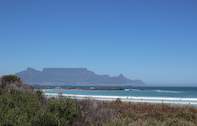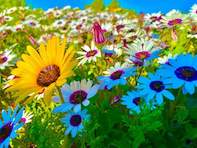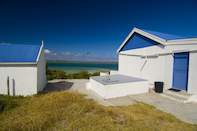Breakfast at Blouberg (or visit Groote Post wine estate). Veldwalk around the Rondeberg Private Nature Reserve. Picnic in the West Coast National Park. Overnight in Langebaan.
Waterfront to Blouberg

Turn left as you leave the Waterfront and follow N1 Paarl. Take second offramp onto R27 (Paarden Eiland, Milnerton). At the traffic lights after 15km turn left into Marine Drive (Blouberg, Atlantic Beach). At 18km turn left into Sir David Baird Drive, then second left into Stadler Road, and Ons Huisie is 400m further.
The Cape Flower Season Route starts with a sweep around Table Bay harbour. After a rather industrial beginning past the factories of Paarden Eiland you reach Woodbridge Island, which marks the start of the Cape West Coast Biosphere Reserve.
Out to sea on your left is Robben Island, most famous as Nelson Mandela's prison for almost two decades. Look back every now and then to see one of the most photographed views in the world - Table Mountain looming majestically out of the sea across Table Bay.
Many photographs on South African holidays are taken from Bloubergstrand (originally Blaauwberg). It's often windy here, but the kite flyers and kitesurfers skimming over the waves make good use of it! There are loads of curios, kites and other goodies for sale along this stretch of Beach Road.
[Café Blouberg] Ons Huisie is the breakfast spot. Originally a fisherman's cottage, this national monument is a great place to tuck into a hearty South African breakfast, a light meal or just a coffee, with gorgeous views of Blouberg beach.
Blouberg to Rondeberg
As you leave Ons Huisie, turn left at the T-junction into Sir David Baird Drive. Go straight through the traffic circle. Turn left at the second circle, then go straight through the third circle. Enter Melkbosstrand (8 km). At the traffic lights at about 18 km, turn left onto the R27 Velddrif. Turn right into Rondeberg at about 56km. The road dips into Melkbosstrand before you rejoin the R27.
You'll be tempted to speed up along this stretch of good tar, but keep a sharp eye open for tortoises making their death defying optimistic way across the road, and if you go too fast you'll miss the roadside flowers that spring up from around this point.
Also look out for guinea fowl, remembering that if one bursts out of the bushes into the road, there are usually a few more following behind. On either side of the road you'll see huge amounts of Port Jackson wattle - large bushes with elongated, dark green leaves, which in spring become a riot of fuzzy yellow flowers.
Pass the turning to Groote Post (that's for Day Four, unless you're seeing a show in Darling), then turn into the Rondeberg Private Nature Reserve about 10 kilometres further on for a close look at Sandveld flowers. At Rondeberg you will be welcomed into a full-time West Coast fynbos reserve.
It's taken over four years, but so far over 800 species of fynbos have been identified on the farm. There's also a dried and pressed specimen of each one in the information centre, along with paintings, life-size watercolours, which were done by artist Lynda de Wet.
But the idea is to get out and see the real thing. Although the West Coast is famous for the rainbow carpets of daisies in spring, there are flowers to be seen almost every single month of the year.
There are guided walks at 11:00 and 15:00 (but book first), covering about three kilometres in two hours, all on the flat so there's nothing too strenuous. Stay for a lunch of traditional farm-made, West Coast fare or head for the West Coast National Park.
Rondeberg to West Coast National Park

At the Rondeberg gate, turn right onto the R27. Pass Yzerfontein turn-off after 48km (see detour below). Turn left into West Coast National Park (R27 gate) at 60 km. You can keep going all the way to Yzerfontein, which is a good place for whale-spotting from June to November.
The West Coast National Park, classified as a wetland of international importance, embraces the majority of the Langebaan lagoon and its islands, attracting an astonishing number of birds.
Between 50 000 and 70 000 birds fly a staggering 15 000 kilometres from northern Russia each year to spend their summer around the lagoon. One of the best things about the park is its bird hides, especially the one near the Geelbek visitors' centre. The walkway creeps out into the lagoon, putting you smack in the centre of the avian action.
But the park's main claim to fame is the floral kaleidoscope in spring, depending on the rains. Straddling both Strandveld and Sandveld, the land becomes a jewelled carpet of vygies, gazanias, daisies and more.
Peak season is August and September, which is also the only time the Postberg Private Reserve is open. There you can look out for eland, kudu, blue wildebeest, springbok and the stripey Cape mountain zebra. About six kilometres from the main gate the road forks around the lagoon.
The Geelbek visitors' centre and restaurant to the right is a good stop for lunch, but otherwise take the left-hand fork down the peninsula. You'll be travelling the right fork later, on your way out of the park to Langebaan. Stop at one of the high points where, on a clear day, you can see all the way to Table Mountain.
The road is good tar, becoming gravel near Postberg. Leave the park via the Langebaan gate, which delivers you right into the middle of town. Look back as you climb away from the gate for beautiful views over the lagoon and town. If all the fresh air is starting to get to you.
Accommodation in Langebaan

Langebaan's your town. You can sit at one of the restaurants on the beach, sipping a little chilled chardonnay while the kite- and windsurfers relish the wind, turning the lagoon into a colourful frenzy of soaring sails. When it's calmer the kayakers take to the water, the anglers hit the rocks and playtime begins.
The lagoon's water is also marginally warmer than that of the sea, although that's not saying too much as the temperature of the sea is icy cold at the best of times. Spend the night in Langebaan - there are oceans of guesthouses and B&Bs to choose from. But for something completely different, how about spending a night in a houseboat, bobbing on the lagoon?
 Self drive routes from Cape Town invite visitors to the Mother City to experience the natural splendour, fun activities and scenic attractio...
Self drive routes from Cape Town invite visitors to the Mother City to experience the natural splendour, fun activities and scenic attractio...